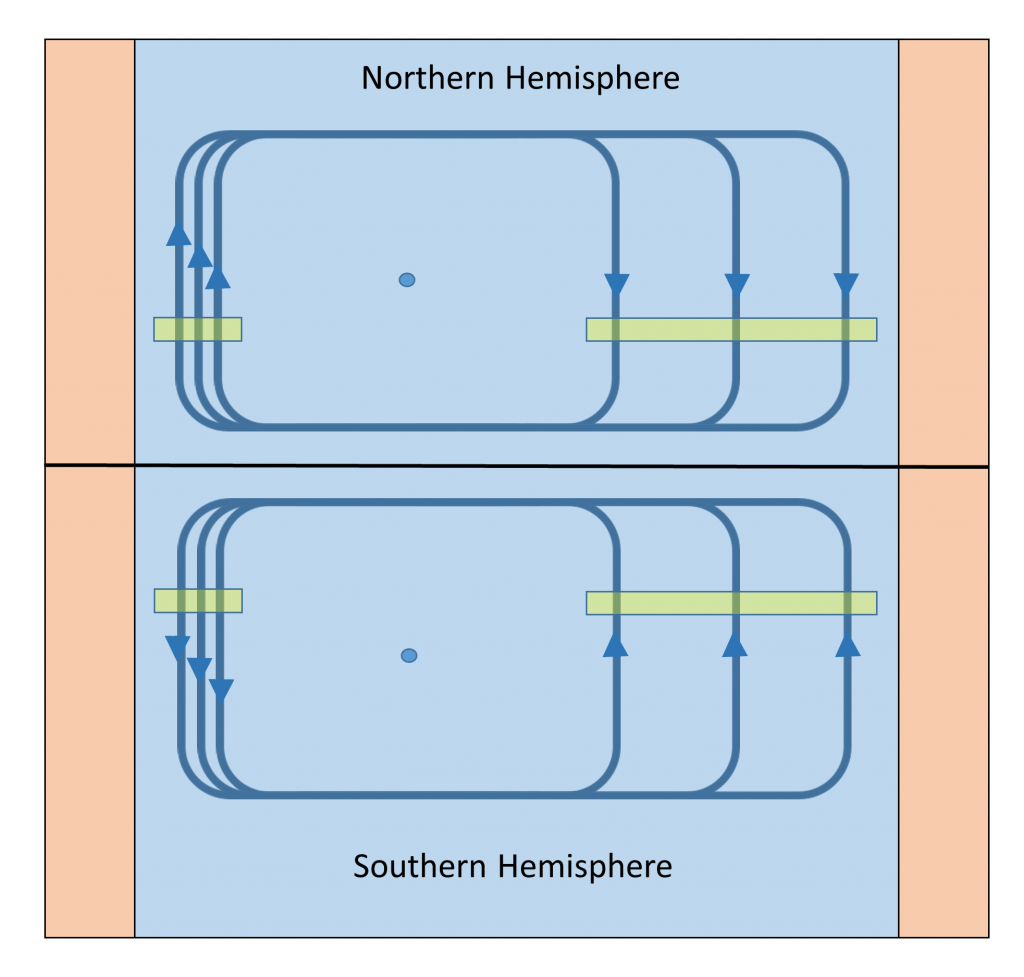9.4 Western Intensification
In both hemispheres, the currents making up the western side of the gyre are much more intense than the currents on the eastern side. In other words, the currents off of the east coast of the continents are more intense than currents off of the west coast of the continents. This phenomenon is known as western intensification, and once again it is due to the Coriolis Effect.
As discussed in section 8.2, the Coriolis Effect is a result of the fact that different latitudes of the Earth are rotating at different speeds, and the apparent path taken by an object is deflected as it moves between areas of different rotation speeds. The greater the change in rotation speed, the stronger the Coriolis force. At the poles, the speed of rotation is 0 km/hr. The speed increases to about 800 km/hr at 60o latitude, 1400 km/hr at 30o latitude, and 1600 km/hr at the equator. Therefore there is an 800 km/hr difference between 60o and 90o latitude, while there is only a 200 km/hr difference between the equator and 30o. Thus the speed of Earth’s rotation changes more quickly with latitude near the poles than at the equator, making the Coriolis force strongest near the poles and weakest at the equator.
The high latitude surface currents of the major gyres experience a strong Coriolis force due to their proximity to the poles. As the currents move eastward, the strong Coriolis force begins to deflect the currents towards the equator relatively early. The currents on the eastern side of the gyre are therefore spread out over a wide area as they move towards the equator (Figure 9.4.1). Near the equator, the westward flowing currents experience a much weaker Coriolis force, so their deflection does not happen until the current is all the way over to the western side of the ocean basin. These western currents must therefore move through a much narrower area (Figure 9.4.1). This imbalance means that the center of rotation of the gyre is not in the center of the ocean basins, but it closer to the western side of the gyre.

The same volume of water must pass through both the east and west sides of the gyre. In the western gyre currents, that volume is passing through a narrower area, so the current must travel faster in order to transport the same amount of water in the same amount of time. On the eastern side of the gyre the current is much wider, so the flow is slower. A simple analogy is the water flowing from a garden hose. You can make the water flow from the hose much faster and more strongly by covering part of the opening with your thumb. The same amount of water is exiting the hose whether the opening is covered or uncovered, but to get that water through the covered opening the flow has to be much faster and stronger. In the same way, western boundary currents are not only faster, but also deeper than eastern boundary currents, as they move the same volume through a narrower space. For example, the Kuroshio Current in the western Pacific is around 15 times faster, 20 times narrower, and 5 times deeper than the California Current in the eastern Pacific.
a large circular ocean surface current (9.1)
currents on the western side of a gyre are faster, deeper, and narrower than currents on the eastern side (9.4)
the tendency for the path of moving bodies (e.g., ocean currents) to be deflected on the surface of the Earth, to the right in the Northern Hemisphere and to the left in the Southern Hemisphere (8.2)
the distance north or south of the equator, measured as an angle from the equator (2.1)
ocean currents whose properties are influenced by the presence of a coastline (9.1)

